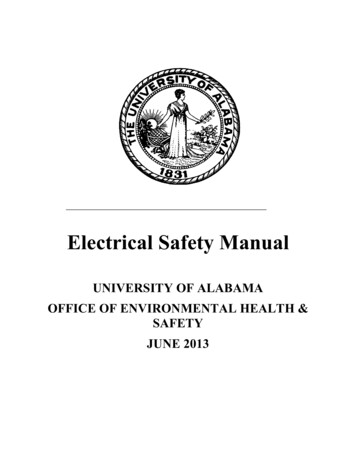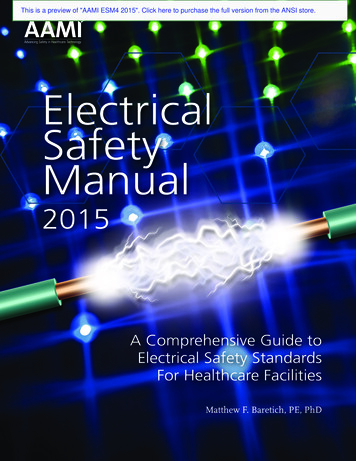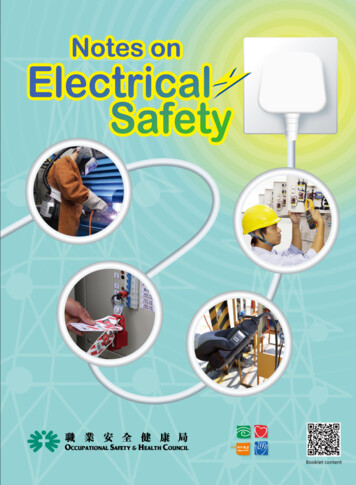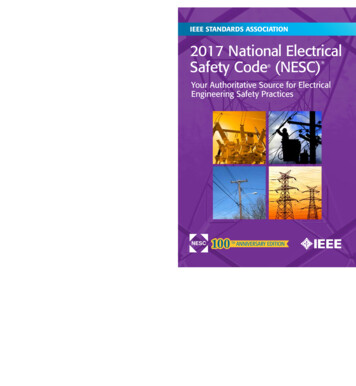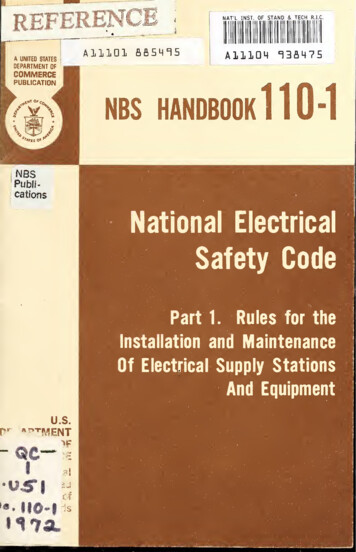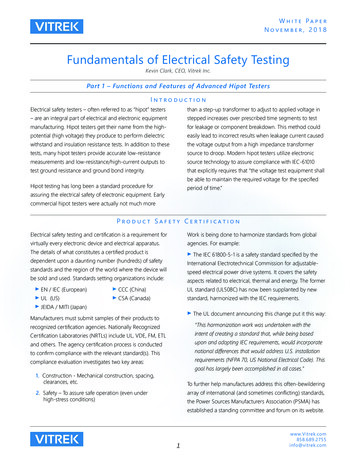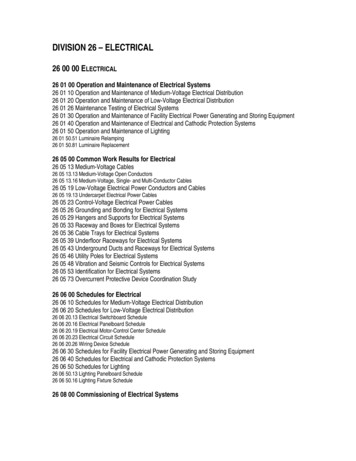
Transcription
Electrical Safety
Who is Shoreline Power Services? Safety Training & Safety Program Services Managing Health & SafetyNFPA 70E Arc Flash TrainingSafety & Health ProgramsFire Protection and PreventionHealth HazardsConfined SpaceLockout/TagoutOSHA 10-30 Hour TrainingWelding & CuttingPersonal Protection EquipmentAnd much more .
Electrical Safety&Arc Flash Familiarization
You will become Familiar with.Hazards of Electricity
You will become Familiar with.Testing Circuits
You will become Familiar with.Isolating Circuits
You will become Familiar with.Work Area Safety
You will become Familiar with.Electrical PPE
You will become Familiar with.Working on EnergizedEquipment
Topic #1Hazards of Electricity
There are four main types ofelectrical injuries
Electrocution(Death due to electrical shock)
An Average of one worker iselectrocuted on the job eachday.
Electricalshock
More than 30,000 non-fatalshock accidents occur eachyear.
Electrical Shock Received when current passes through the body Severity of the shock depends on: Path of current through the body Amount of current flowing through the body Length of time the body is in the circuit LOW VOLTAGE DOES NOT MEAN LOW HAZARD
Burns
As much as 80% of all electrical injuries are burnsresulting from an arc-flash and ignition offlammable clothing.
Electrical Burns Most common shock-related, nonfatal injury Occurs when you touch electrical wiring or equipment thatis improperly used or maintained Typically occurs on the hands Very serious injury that needs immediate attention
Falls
Electrical Safety Special Training is required for work on electrical equipment Only Authorized Employees may conduct electrical work
Electrical SafetySpecial Training is required for work on electrical equipmentOnly Authorized Employees mayconduct electrical work
Authorized person: A person approvedor assigned by the employer to perform aspecific type of duty or duties or to be ata specific location or locations at thejobsite.
Overload Hazards If too many devices are plugged into a circuit, the current will heatthe wires to a very high temperature, which may cause a fire If the wire insulation melts, arcing may occur and cause a fire in thearea where the overload exists, even inside a wall
Ground-Fault CircuitInterrupter This device protects you from dangerous shock The GFCI detects a difference in current between the black and whitecircuit wires(This could happen when electrical equipment is not workingcorrectly, causing current “leakage” – known as a ground fault.) If a ground fault is detected, the GFCI can shut off electricity flow in aslittle as 1/40 of a second, protecting you from a dangerous shock
Grounding Path The path to ground from circuits, equipment, and enclosures must bepermanent and continuous Violation shown here is an extension cord with a missing groundingprong
Visually Inspect Portable cord and plug connected equipment and flexible cord sets(extension cords) shall be visually inspected before use on any shiftfor external defects: Loose partsDeformed or missing pinsDamage to outer jacket or insulationEvidence of possible internal damage
Portable Electric Tools &Cords Portable equipment must be handled in a manner which will notcause damage. Flexible electric cords connected to equipment may not be used forraising or lowering the equipment. Flexible cords may not be fastened with staples or otherwise hung insuch a fashion as could damage the outer jacket or insulation.
Remove from Service If there is a defect or evidence of damage to any electrical tools orequipment Immediately notify your supervisorRemove the item from serviceTell your co-workers
Use of Flexible Cords More vulnerable than fixed wiring Do not use if one of the recognized wiring methods can be used instead Flexible cords can be damaged by: Aging Door or window edges Staples or fastenings Abrasion from adjacent materials Activities in the area Improper use of flexible cords can cause shocks, burns or fire
Permissible Uses of FlexibleCordsExamples
Prohibited Uses of FlexibleCordsExamples
Clues that ElectricalHazards Exist Tripped circuit breakers or blown fuses Warm tools, wires, cords, connections, orjunction boxes GFCI that shuts off a circuit Worn or frayed insulation around wire orconnection
Overhead PowerlineHazards Most people don’t realize that overhead powerlines are usually notinsulated Powerline workers need special training and personal protectiveequipment (PPE) to work safely Do not use metal ladders – instead, use fiberglass ladders Beware of powerlines when you work with ladders and scaffolding
Safe Work PracticesBefore starting work - De-energize, Lock, Tag & Test allcircuits of 50 volts or more- De-energize all Power Sources- Disconnect from all electric energysources
Control DevicesControl circuit devices such as push buttons selector switches interlocks may not be used as the sole means for de-energizingcircuits or equipment.
Lock & Tag Lock & Tag all Sources Place Lock & Tag on each disconnecting meansused to de-energize circuits Attach Lock so as to prevent operating thedisconnecting means Place Tag with Each Lock
If a Lock cannot beapplied A tag used without a lock must be supplemented by at least oneadditional safety measure that provides a level of safety equal to thatof a lock. Examples: Removal of an isolating circuit element such as a fuse Blocking of a controlling switch Opening of an extra disconnecting device.
Energized .Working with Energized Parts: Persons working on energized equipment mustbe familiar with the proper use of specialprecautionary techniques, personal protectiveequipment, insulating and shielding materials,and insulated tools.
Working on energizedcircuits When working on energized circuits Isolate the area from all trafficPost signs & barricadesUse an attendant if necessaryUse insulated tool, mats and sheetingUse electrical rubber sheeting to cover nearby exposed circuits
Arc Flash & Arc Blast Arc Flash – electrical short circuit that occurs when air flashes from anexposed live conductor, to either another conductor or to ground. Arc Blast – pressure wave caused by the arc flash
Arc Flash/Blast Concentrated energy explodes outward High intensity flash Temperatures can reach 35,000 (skin ignites 480) Pressure wave can reach 200lbs/sq. inch Vaporizes conductors and copper with exploding particles.
Arc Flash Effects Severe burns Broken bones Vision damage Hearing loss Brain/internal injuries Punctures and lacerations Death
Causes of Arc Flash Improper training Improper work procedures Dropped tools Accidental contact with electrical systems Installation failure Improper Design/Repair Voltage testing with inappropriate equipment
Causes of Arc Flash (cont.) Buildup of dust, corrosion on insulating surfaces Lack of maintenance Sparks produced during racking of breakers, replacement of fusesand closing into faulty lines. Over confidence
All power circuits and electrical equipment shallbe deenergized before work is done on suchcircuits and equipment, except when necessaryfor trouble shooting or testing.
1000-Volt InsulatedTools
Conductive Apparel Remove all conductive articles of jewelry andclothing, such a watch bands, bracelets, rings,key chains, necklaces, metalized aprons, clothwith conductive thread, or metal headgear.
Test Instruments. Test instruments, equipment & test leads, cables, powercords, probes, and connectors must be visually inspectedfor external defects and damage before the equipment isused. Remove any defective items from service
Instrument Ratings Test instruments and equipment & accessories mustbe: Rated for the circuits and equipment to which theywill be connected Designed for the environment in which they will beused
Is it “Dead”? Verify System is De-energized Operate the equipmentcontrols to check thatequipment cannot berestarted. Use test equipment to test the circuits & electrical parts forvoltage & current
Check your tester Check test equipment (Volt-Ohlm Meter) on a known live source ofsame rating to ensure it works before and after checking the circuiton which you will be workingLDL(LIVE-DEAD-LIVE)
Personal ProtectiveEquipment Use electrical rated protective equipmentwhen working in areas where there is apotential electrical
Suits
Voltage Rated GlovesAir Test Before Every UseRequired TestingEvery6-MonthsHigh Voltage Glove Testing
Glove Classifications
Electrically Rated FootwearBoots&Shoes
Work Area Safety You must be able to see what you are doingwhen working on energized equipment
Alerting others Use safety signs, safety symbols, oraccident prevention tags to warn othersabout electrical hazards which mayendanger them.
Hazards of Electricity Testing Circuits Isolating Circuits Work Area Safety Electrical PPE (Personal Protective Equipment Working on Energized Equipment
Its Your Job . Know the hazards of electricity Know the equipment Use Safe Work Practices Inspect your PPE before each use Don’t work on energized circuits withoutpermission
It’s your life
Electrical Safety Special Training is required for work on electrical equipment Only Authorized Employees may conduct electrical work. Authorized person: A person approved or assigned by the employer



